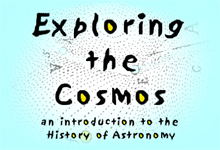

Department of History
University of California, Irvine
Instructor: Dr. Barbara J. Becker
![]()
Lecture 10. Time and Place.
![]()
The Problem of Longitude |
The Earth spins on a north-south axis that hardly changes its orientation from century to century. This accounts for the relative stability in the north-south orientation of the map of the fixed stars. Using familiar celestial markers as guides (the star Polaris, for example), a navigator out in the open sea can readily determine her geographic latitude (position north or south of the equator). Figuring out her longitude (position in the east-west direction) is a different story. There is nothing comparable to the equator or the poles for the navigator to use as reference points. It is inconvenient for everyone around the globe to awaken, work and sleep according to a schedule defined by a single global clock. Most people in Hong Kong, Los Angeles and Nairobi prefer to rise with the Sun, mark the noon hour when the Sun crosses the local meridian and sleep after the Sun has set. The Earth makes one complete turn on its axis nearly every twenty-four hours. As shown in the illustration above, every 15° of longitude (360° ÷ 24) marks a difference of one hour in local time. Longitude measures are intimately connected to time -- in particular, to comparisons of local time in different parts of the globe. To see how a navigator in the open sea can use time to determine her longitude, imagine that each day, when her trusty chronometer tells her it is precisely noon in London, she determines her own local time by observing the Sun's position on the sky. On the first day, when her chronometer strikes twelve noon, she notes her local time is 11 a.m., a reading that lets her know she is currently located 15° west of London. On the second day, she sees that her local time is only 10 a.m., an indication that she is now 30° west of London. Unfortunately, her chronometer falls and breaks on the third day! With no way of knowing when it is precisely noon in London, she has no signal to tell her when to measure her local time. Unable to compare her local time with time in London, she is left with no easy way to determine her longitude. Reliable and accurate chronometers are a modern invention. Mariners have ventured across the open sea for centuries. How did the early seafaring adventurers determine their longitude? |
Significant Events in the Search for a Solution to the Longitude Problem |
||||||||||||||||||||||||||||||
1514 |
Johannes Werner (1468-1522) of Nuremberg proposed a method of "lunar distances". The Moon moves fairly rapidly from West to East against the background array of the fixed stars. Astronomers in or near a port city created tables based on years of careful mapping of the Moon's motion. The tables list -- for each hour of the day -- the expected separation of the Moon from a set of easily recognized bright stars. After measuring the Moon's distance from a particular star, a mariner can use the prepared tables to find out what time it is in his port city. Once that time is known, he can compare it to his local time and calculate his longitude. |
|||||||||||||||||||||||||||||
1530 |
Gemma Frisius (1508-1555) of Antwerp proposed using a portable mechanical clock that could be set to a port city's local time before setting out to sea. So long as the clock could be relied upon to keep accurate time, a mariner would only have to measure his local time in order to determine his longitude. |
|
||||||||||||||||||||||||||||
1550 |
|
|||||||||||||||||||||||||||||
1585 |
Jost Bürgi (1552-1632), Swiss clockmaker, developed a more accurate mechanical clock. | |||||||||||||||||||||||||||||
1598 |
Philip III of Spain offered a large monetary prize to the individual who solved the longitude problem -- a perpetual pension of 6,000 ducats, a life annuity of 2,000 ducats, and a cash prize of 1,000 ducats. | |||||||||||||||||||||||||||||
1610 |
Galileo (1564-1642) discovered 4 moons of Jupiter. | |||||||||||||||||||||||||||||
1636 |
Galileo proposed using a mechanical clock and the moons of Jupiter to determine longitude. | |||||||||||||||||||||||||||||
1657 |
Christiaan Huygens (1629-1695), Dutch astronomer, physicist, mathematician created the first working pendulum clock. | |||||||||||||||||||||||||||||
1660 |
Huygens began working on improved pendulum clock for use at sea. | |||||||||||||||||||||||||||||
1667 |
Paris Observatory founded.
|
|||||||||||||||||||||||||||||
1668 |
A chart showing pictures of the predicted positions of Jupiter's satellites at 7 p.m. on each day in January 1668. Mariners could estimate their local time at sea by observing Jupiter with a telescope and then comparing the arrangement of Jupiter's moons they saw with those depicted on the chart. | 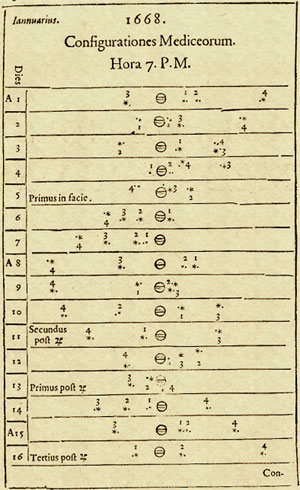 |
||||||||||||||||||||||||||||
1675 |
John Flamsteed (1646-1719) was appointed the first Astronomer Royal by King Charles II. He was the first (and for a long time, the only) scientist paid an annual salary for service to the English crown.
|
|||||||||||||||||||||||||||||
1676 |
Flamsteed took up residence at Greenwich Observatory, located near London atop a high hill bordering the Thames River. The building was designed by Christopher Wren for the Astronomer Royal's use. Although Flamsteed was given a building from which to observe, no provision was made for the purchase observing instruments! Flamsteed purchased or commissioned the construction of many instruments at his own expense.
|
|||||||||||||||||||||||||||||
1707 |
Loss of Admiral Clowdisley Shovell's fleet off the coast of the Scilly Isles -- 1,647 perished. | |||||||||||||||||||||||||||||
1714 |
Queen Anne (1665-1714) of Great Britain and Ireland established a longitude prize -- £20,000!! | |||||||||||||||||||||||||||||
John Harrison and the Longitude Prize |
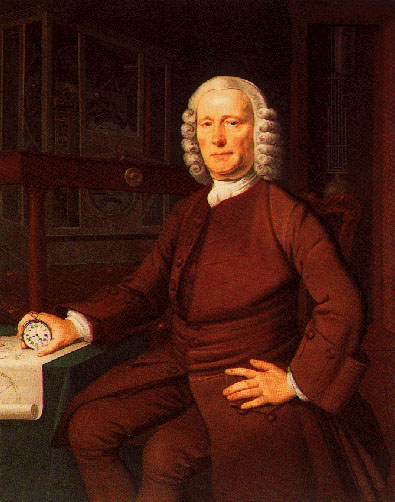
John Harrison (1693-1776) |
Notable Events in Harrison's Life |
1693 |
born in Yorkshire |
1725 |
investigated effects of temperature change on expansion and contraction
of metals
used results of experiments to design gridiron pendulum |
1726 |
completed two "regulators" made of wood, accurate to within one second per month |
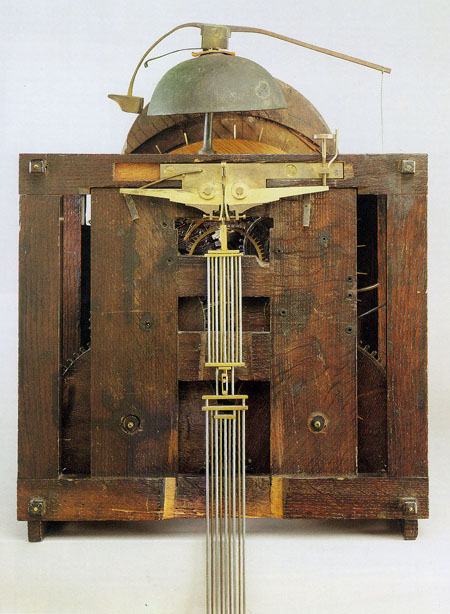
|
|
1730 |
John Hadley (1682-1744) invented a new, more accurate altitude-measuring
instrument -- the "octant" or "Hadley's quadrant"
accurate to within 3 minutes of a degree (~ 3 mi) |
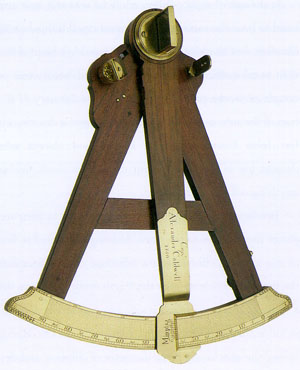
Hadley's quadrant |
|
1730 |
Harrison obtained support from Astronomer Royal Edmond Halley and clockmaker George Graham for his plan to build H1 |
1735 |
H1 completed |

H1 weight = 75 lbs size = 4' X 4' X 4' |
|
1736 |
H1 sent on trial run to Lisbon |
1737 |
Commissioners of the Board of Longitude met for the first time
|
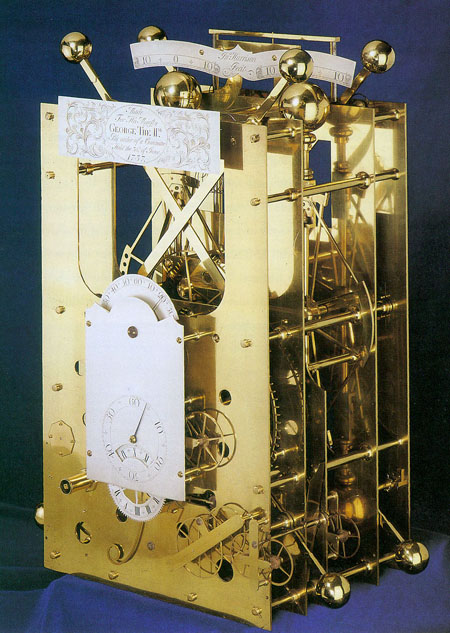
H2
|
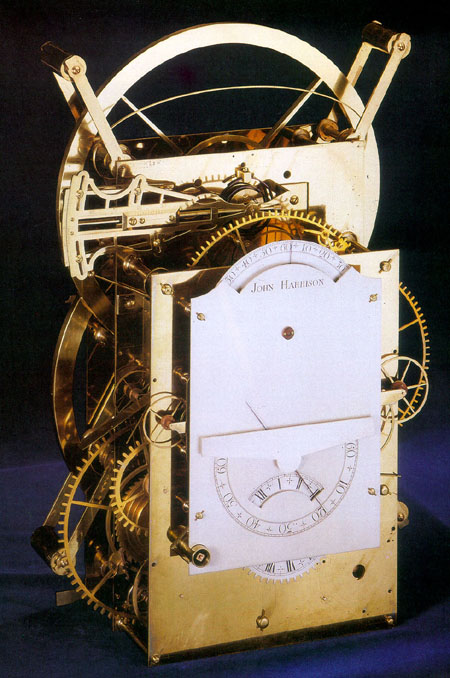
H3
|
1739 |
H2 completed |
1740 |
Harrison started work on H3 |
1742 |
death of Halley; James Bradley (1693-1762) appointed third Astronomer Royal |
1749 |
Harrison awarded the Royal Society's prestigious Copley medal |
1757 |
most of the work on H3 completed |
1769 |
H4 completed |
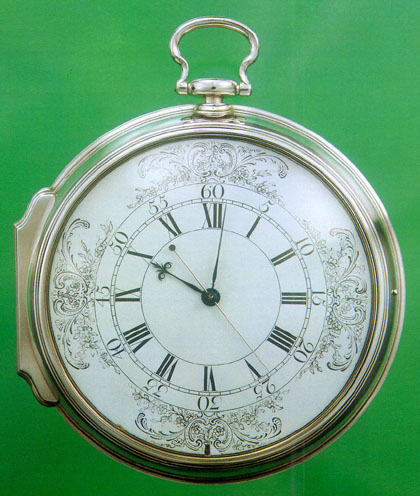
H4 weight = 3 lbs size = 5 in. diameter |
|
1761-2 |
first voyage to test H4 made to Jamaica on the Deptford
by determining their position at sea using H4, the crew of the Deptford was able to correct the ship's course and avoid delays that would have resulted had they relied solely on estimates based on traditional methods |
1763 |
Nevil Maskelyne (1732-1811) published the first Mariner's Guide |
1764 |
second voyage to test H4 made to Barbados on the Tartar (return to England on the New Elizabeth). |
1765 |
Maskelyne appointed fifth Astronomer Royal
H4 examined by committee appointed by Board of Longitude Harrison awarded half of longitude prize money!! Board ordered Harrison to turn over--
|
1766 |
Harrison ordered to turn over H1, H2, and H3
H1 is dropped and damaged in transit |
1767 |
Larcum Kendall requested to make copy of H4
Harrison began work on H5 |
1770 |
Kendall completed H4 copy called K1
|
1772 |
Harrison wrote to King George III |
1773 |
Harrison given £8,750 by special act of parliament |
1774 |
new act of parliament set out terms for winning the prize; all entries
must:
|
1776 |
death of Harrison |
Rupert T. Gould (1890-1948) and H2
|
|